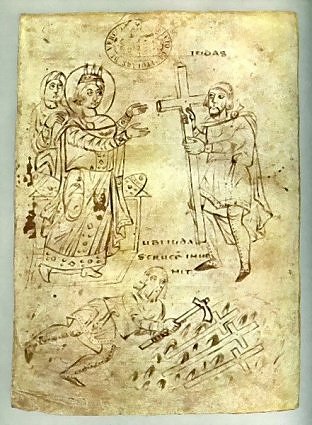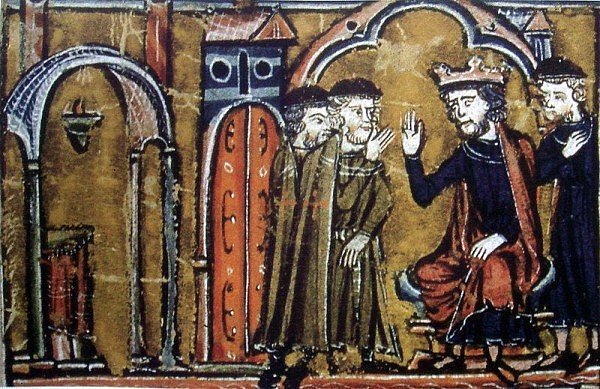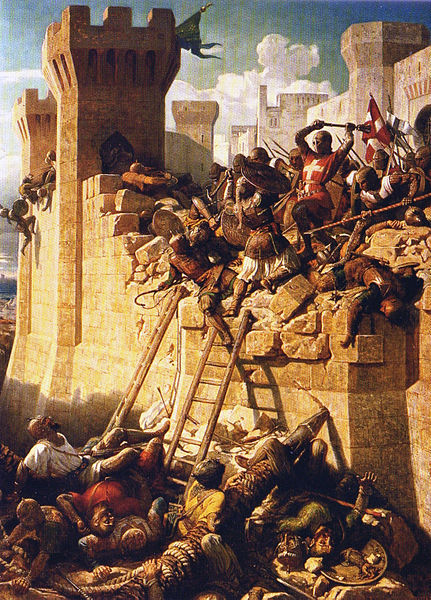The Knights Templar have been linked to the Mystery of Rennes-le-Château from the very beginning. Largely beacuse of suspicions that they hid part of their treasures in the region, perhaps including the results of their digs under the Temple Mount. There are many local legends that speak of the Ark of the Covenant, the body of Jesus or the Holy Grail being buried in the area around Rennes-les-Bains.
It is fact that there were once Knights Templar in the area. In the 12th Century, Bernarus Sismondi de Albezuno, Lord of Bézu and two brothers from the Reddas family became members of the order. The story that the Château de Blanchefort was once a Temple Commanderie is an omission. The Blancheforts of Rennes weren’t related to the family of the sixth Grandmaster of the Knights Templar. One story claims Bertrand de Blancafort asked the Knights Templar to help him exploit a goldmin near his castle in 1130.
A bit of history

St Helena finds the True Cross / N. Italy, 825 AD Biblioteca Capitolare, Vercelli
The History of the Knights Templar starts with the crusades of the Middle Ages, a warbetween Christians and Moslems centered around the city of Jerusalem.
After Christ was crucified on the cross, his body was laid in a tomb, now known as the Holy Sepulchre. Legend states that about three hundred years after the death of Christ, Helena, the mother of the Christian Roman Emperor Constantine, discovered the Holy Sepulchre and her son built the magnificent Church of the Holy Sepulchre over the sacred spot in Jerusalem in 330 A.D.
The Church of the Holy Sepulchre commemorates the hill of crucifixion and the tomb of Christ. Pilgrims throughout the Middle Ages made pilgimages to the Holy city of Jerusalem.
In A.D. 637 Jerusalem was surrendered to the Saracens. The caliph of the Saracens called Omar gave guarantees for the safety of the Christian population and because of this pledge the number of pilgrimages to Jerusalem still continued to increase. In 1065 Jerusalem was taken by the Turks, who came from the kingdom of ancient Persia. 3000 Christians were massacred and the remaining Christians were treated so badly that throughout Christendom people were stirred to fight in crusades. The Knights Templar were formed to to ensure the safety of the pilgrims of the Middle Ages who flocked towards Jerusalem. Their original name was the Poor Fellow-Soldiers of Christ.
In 1099 Crusaders led by Godfrey of Bouillon took Jerusalem back from the Turks. The founding of the Knights Templar was initiated shortly after this date by Bernard of Clairvaux, a member of the Cistercian Order.
The 10 Jerusalem years

Baldwin II cedes Temple of Salomon to Hugues de Payens and Gaudefroy de Saint-Homer in 1119 / Guillaume de Tyr, 13th century “Histoire d’Outre-Mer”
At first the Knights Templar had no church and no particular place of to stay. In 1118, nineteen years after the freeing of Jerusalem, King Baldwin II of Jerusalem, granted the Knights Templar a place to live within the sacred enclosure of the Temple on Mount Moriah. This place was amid the holy structures which were exhibited by the priests of Jerusalem as the Temple of Solomon. The “Poor Fellow-soldiers of Jesus Christ” became colloquially known as “the Knighthood of the Temple of Solomon” and subsequently the Knights Templars.
Hugues de Payens was chosen by the knights to be the superior of their new religious and military society. The new order took vows of poverty and chastity, and the king granted them quarters within the Temple of Solomon – hence their name Knights of the Temple, or Templar. Hugues de Payens was known by the title “the Master of the Temple”.
While living in what today constitutes the Al Aqsa Mosque in Jerusalem, the Knights Templars are believed to have spent ten years digging under the Temple Mount, allegedly searching for the treasures of the Temple and of King Solomon. Traces of such digs were found in 1867 when a certain Captain Wilson, Lieutenant Warren and a team of British Royal Engineers uncovered evidence to back the idea of Templar digging.They re-excavated the area and uncovered tunnels extending vertically from the Al Aqsa mosque, down to about 25 meters before fanning out under the Dome of the Rock Mosque. Supposedly, Crusader artifacts were found in these tunnels.
It is a documented fact that the Knights Templar had a more than average interest in relics and everything physically realting back to the stories in the bible. In april 2009 for example records were found in the Vatican Secret Archives proving that the Order was once in possession of the Shroud of Turin.
Hugues de Payens and his Knights Templar returned to France in 1127, perhaps in the possession of the treasures of Jerusalem.
Expansion and rise to power
The first donation of land was given to the Templars in 1127 by Count Thybaud of Champagne at Barbonne-Fayel, fifty kilometres north-west of Troyes. Hugues de Payens was granted the land for the first Temple Church in Holborn, London in 1128 where the original Knights Templar Temple was built. The temple was the first round church and consisted of gardens, orchard, boundary ditch and cemetery.
The then already famous preacher St. Bernard of Clairveaux and Hugues de Payens travelled to Rome, accompanied by Geoffrey de St. Aldemar as well as four other brothers of the order ( Brother Payen de Montdidier, Brother Gorall, Brother Geoffrey Bisol, and Brother Archambauld de St. Armand ). They were received with great honour by Pope Honorius, who approved of the objects and designs of the holy fraternity. Subsequently in 1128 the ecclesiastical Council of Troyes gave the Knights Templar official recognition and granted their rule of the order. The Council of Troyes was instigated by Bernard of Clairvaux and the Knights Templars were represented by Hugues de Payen and André de Montbard. The Papal approval at the Council of Troyes resulted in many new recruits joining the order.
In 1130, Bernard of Clairvaux drew up the rules for the new Knights Templar order. Bernard set up the order with two main classes of knighthood, the knights and sergeants or serving brethren. Sergeants or serving brothers wore a black or brown mantle to show their lower status, whilst the Knights wore a red cross granted by Pope Eugenius III. Married men who joined the order could only join as sergeants, their property coming into the possession of the Order rather than to their wives upon their death.
In 1130 the Knights Templar order were receiving privileges from Alfonso I of Spain. The Templars helped the rulers of Catalonia and Aragon regain land from the Moors. King Alfonso I granted the Knights Templar exemption of tax on a fifth of the wealth taken from the Moors and on his death he left a third of his kingdom to them. This was later successfully contested but the Templars were given land in Aragon, Catalonia, Valencia and Mallorca.
In 1136 Hugues de Payens died and was succeeded by Robert de Craon as Master of the Temple. The Knights Templar in England supported Stephen in his efforts to gain the throne of England in 1136. Stephen became King of England and the Knights Templar were awarded the wealthy manor of Cressing.
A Papal Bull was issued in 1139 by Pope Innocent II, a protege of St. Bernard of Clairvaux, stating that the Knights Templar should owe allegiance to no one other than the Pope himself.
The Knights Templar History saw 1146 as the year when the Knights Templar order adopted the splayed red cross as their emblem. The Battle cry of the Templars was “Beau-Séant!” which was the motto they bore on their banner.
The Knights Templar order supported the second crusade in 1148. The decision was made to attack Damascus and armies were assembled in Acre.
In 1154 under King Henry II of England , the Grand Master of Knights Templar ( André de Montbard ) superintended the Masons. The Knights Templar built their Temple in Fleet Street. The Knights Templar moved their London temple to the new site between Fleet Street and the Thames in 1161.
Their involvement in English politics increased as Richard de Hastings, the Master of the English Templars, attempted to reconcile the differences between King Henry II and Thomas Becket. Their attempts to reconcile the two parties failed and Thomas a Becket was murdered in Canterbury Cathedral in 1170
The army of Jerusalem and Guy of Lusignan, the King of Jerusalem, was beaten by Turkish forces in 1184. All Knights Templar and Hospitallers who survived the battle were executed afterwards. This event prompted the Third Crusade headed by Richard the Lionheart who was supported by the Knights Templar order. The city of Acre is taken by the Crusaders in 1191. Richard the Lionheart dies in 1199 and is succeeded by his brother John.
The Knights Templar History goes on and in 1263 problems in England lead to the Baron’s revolt led by Simon de Montfort opposing Edward I. On the pretence of removing his mother’s jewels, Edward I entered the Knights Templar Temple in London and ransacked the treasury, taking the proceeds to the Tower of London. In 1271 Edward leads another crusade and is attacked by an assassin with a poisoned knife. He survives the attack and his life was saved with drugs sent by the master of the Knights Templar, Thomas Bérard. In 1272 King Henry III of England died and the English Council met at the Temple in London and draft a letter to Prince Edward informing him of his accession to the throne, illustrating the political importance of the Knights Templar in England.
The beginning of the end
The Knights Templar suffer a huge defeat at Acre in 1291 and cease to be a strong fighting force. More The Knights Templar are recruited after the defeat at Acre but the new force are wiped out at Raud in 1302.
King Philip IV of France (1268-1314) who was already heavily in debt to the Knights Templar requested a further loan. The Knights Templar refused his request. King Philip IV subsequently ordered the arrest of all Knight Templars in France. The order to arrest the Templars was sent out several weeks before the date possibly giving the Templars time to hide their wealth. On 11 October, two days before the arrest of many Templar Knights, it is recorded in French Masonic history that Templar ships left La Rochelle, heading to Scotland. On Friday the 13th, in October 1307, Jacques de Molay, the Grand Master of the Knights Templar, and 60 of his senior knights were arrested in Paris. The Templars were charged with Satanism and many other “unnatural” acts and practices. Many of the charges may have been complete fabrications, but some could have been distortions of secret rites of the Templars. There were torture-encouraged confessions in the style of the Spanish Inquisition, and many were found guilty for refusing to “confess”. Pope Clement V initiated enquiries into the order and some 15,000 Knights Templar were arrested across Europe. The Medieval order of the Knights Templar became extinct in 1312 when the order was dissolved by the Council of Vienne. Anyone found sheltering a Templar was under threat of excommunication. Much of the Templar property outside of France was transferred by the Pope to the Knights Hospitallers, and many surviving Templars were also accepted into the Hospitallers.
 The Knights Templar leaders Jacques de Molay and Geoffroi de Charney were burnt at the stake on March 18th 1314 for rescinding their former admission of heresy under torture. Jacques de Molay cursed the Pope and King Philip and prophesied that they would soon die. Pope Clement V was dead within 40 days and King Philip died that year. Jacques de Molay was the last official Master of the Knights Templar.
The Knights Templar leaders Jacques de Molay and Geoffroi de Charney were burnt at the stake on March 18th 1314 for rescinding their former admission of heresy under torture. Jacques de Molay cursed the Pope and King Philip and prophesied that they would soon die. Pope Clement V was dead within 40 days and King Philip died that year. Jacques de Molay was the last official Master of the Knights Templar.
Back to Rennes-le-Château then: In his book Rennes-le-Château et l’énigme de l’or maudit, French veteran author and researcher Jean Markale claims that the Templars inhabiting the Château de Bézu were the only ones not arrested on the notorious Friday 13th October 1307. In contrast to all other Templars in France they reported to the Counts of Barcelona.
After the end
Following the declared end of the Templars in 1312, the Order continued in secret, with Jean-Marc Larmenius the first Grand Master of the now-secret organization, and the Order continued with an uninterrupted line of Grand Masters. In 1705, a convention of Templars at Versailles elected Philip, Duke of Orleans, as Grand Master. This Philip (le Régent) became Regent of France in 1715. With a combined Regent and Grand Master, the Order of the Temple was renewed and legitimized as a Secular Military Order of Chivalry.
Following the death of le Régent in December, 1723, Grand Masters continued, through the three Princes of Bourbon (until 1776), the Duke de Cosse Brissac (until his execution during the French Revolution in 1782), and Radix de Chevillon. In the early 19th century, the Order expanded, with over 20 Convents in France and Priories set up across Europe.






